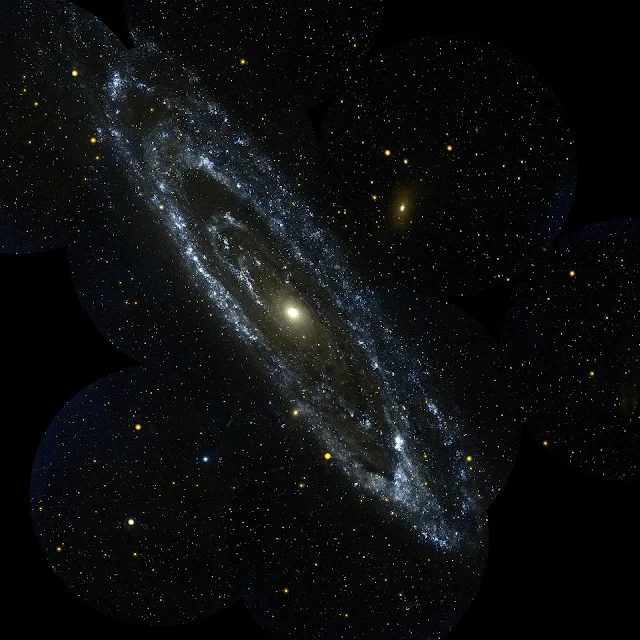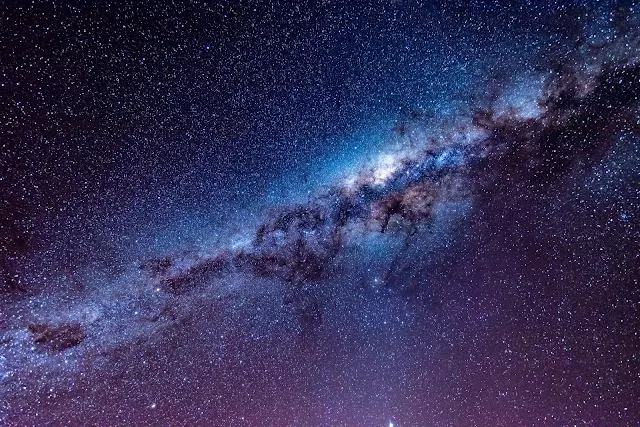Andromeda Galaxy From Earth
 |
| Andromeda Galaxy From Earth |
The story begins in the early 1900s, when astronomer Vesto Slipher measured the radial velocity of Andromeda, in other words, he calculated how fast the galaxy was approaching or receding from Earth.
His measurements convincingly proved that this is not a cluster of stars and gas in our Milky Way, but a completely independent galaxy, quite far away from the Milky Way. Edwin Hubble did just that, calculating an astonishing distance of 2.5 million light-years, thus proving the existence of other galaxies or "island universes" in space. Later, astronomers for decades believed that the galaxy was approaching nearly 200 miles per second (300 kilometers per second), but later astronomers disagreed. Over the years, astronomer Edwin Hubble proved that Curtis claimed that Andromeda is actually an independent galaxy.
It wasn't until the 20th century that astronomers were able to split the Andromeda spiral nebula into individual stars. This discovery led to controversy over whether the Andromeda spiral nebula and other spiral nebulae are located inside or outside the Milky Way. In the 1920s, Edwin Hubble finally solved this problem when he used variable Cepheid stars in the Andromeda galaxy to determine that it is indeed a closed universe that lies outside our own Milky Way galaxy. For centuries, astronomers have viewed the Andromeda Galaxy as a component of the Milky Way, a so-called spiral nebula very similar to other luminous masses of gas within the local galactic system (hence the incorrect name for the Andromeda nebula).
Astronomers use the Andromeda galaxy to conduct detailed studies, trying to understand the evolution and origin of the galaxy. The Andromeda Galaxy, also known as "M31", is a spiral galaxy located 2.2 million light-years away from Earth, facing the constellation Andromeda, as shown in the figure below. As Andromeda moves through the universe, it carries 14 dwarf galaxies, including M32, M110, and M33 (triangular galaxies). It is one of the few galaxies we can see from the earth, which explains a lot, because it is 2.5 million light-years away from us. The Andromeda Galaxy is the most distant object in space that we can see with the naked eye. It is more than 2 million light years away, but this fall, you can see it in the evening sky.
Even though it has been visible for weeks now, if you know where to look, anyone with an inky black night sky or (more likely) with small binoculars will be able to see the famous galaxy (also called M31) high at east. sky after sunset. The most distant object that you can see with the naked eye at a distance of about 2.5 million light years, M31 is our sister galaxy and contains about a trillion stars. From mid-northern latitudes, Andromeda - M31 - can be seen at least part of every night all year round.
 |
| Andromeda Galaxy From Earth |
In areas of low light pollution, the Andromeda galaxy can be seen as a small blur just below the central bulge of the Milky Way. Located in the constellation Andromeda, it is the closest spiral galaxy to the Milky Way, where our solar system is located, although overall it is not the closest galaxy to the Milky Way. It is located approximately 2,480,000 light-years from Earth; its diameter is about 200,000 light years; and shares several characteristics with the Milky Way system. It is a pancake-shaped disk spiral galaxy, and in normal light, the rings of Andromeda's galaxy appear closer than the spiral arms.
You will likely see the galaxy's brighter center and dimmer outer expansions. The photographs show the galaxy's spiral arms, separated by dark streaks of dark dust. The images show streaks of dust and stars that extend to the outer disk.
Observing this galaxy with a small telescope is impressive, although you may be disappointed by not seeing the details that appear in the photo. In the best area of the dark sky, the Milky Way can indeed be seen with the naked eye. With the naked eye, we can only see ten galaxies, and Andromeda is one of them.
The Andromeda Galaxy is composed of 25 dwarf satellite galaxies, and it is estimated that its two spiral arms contain more than 1 trillion stars. From edge to edge, the diameter of the Andromeda Galaxy is about 220,000 light years, more than twice ours. One of the open star clusters closest to the Earth in Cancer, its 1,000 stars are a beautiful sight seen through binoculars. In this dim, fuzzy place, we saw the combined light of about one trillion stars.
In the universe known since the Big Bang (13.5 billion years ago), astronomers believe that there are at least 2 trillion or 2 trillion galaxies in the universe soup. Think about it: the light you see from this huge galaxy left the Andromeda star 2.5 million years ago and arrived here in October 2020. In 4 billion years, our Milky Way will collide with our large galaxy. Spiral neighbor, Andromeda. In about 3.75 billion years, the Andromeda Galaxy and the Milky Way will collide and merge into a huge elliptical galaxy.
In 2010, a group of astronomers believed that M31 was formed 500 to 9 billion years ago, when two smaller galaxies collided and merged. At around 21:00, it is high in the northeast. During the Arizona period, the Andromeda Galaxy was part of the ancient constellation Andromeda, the daughter of Cassiopeia and Cassiopeia. According to recent research, the Andromeda Galaxy is located in an area called the "green valley" on the galactic scale. This area is inhabited by galaxies such as the Milky Way, from the "blue cloud" (the galaxy is forming new stars) to the "red sequence" ( Galaxies without star formation).
An all-sky survey of two microns (2MASS) and the Spitzer Space Telescope show that the Andromeda galaxy has a barred spiral structure. The increase in size allows scientists to speculate if there is a halo in the Milky Way galaxy, and if so, the two halos may already merge as the galaxies approach.
Although the details depend to a certain extent on the structure of the Milky Way, especially our hypothesis of the dark matter halo that contains the Milky Way and the visible disk of Andromeda, the overall picture is clear. About 4.5 billion years later, the Milky Way will crash into the rapidly approaching Andromeda, and astronomers are still trying to predict what will happen when the two galaxies collide. Unlike other galaxies in our outer space, they are moving away from us at an ever faster speed due to the expansion of the universe, and the Andromeda Galaxy will collide with the Milky Way for about 4.5 billion years. It still has a long way to go—about 2.5 million light-years—but it may hit the Milky Way in about 4 billion years.
